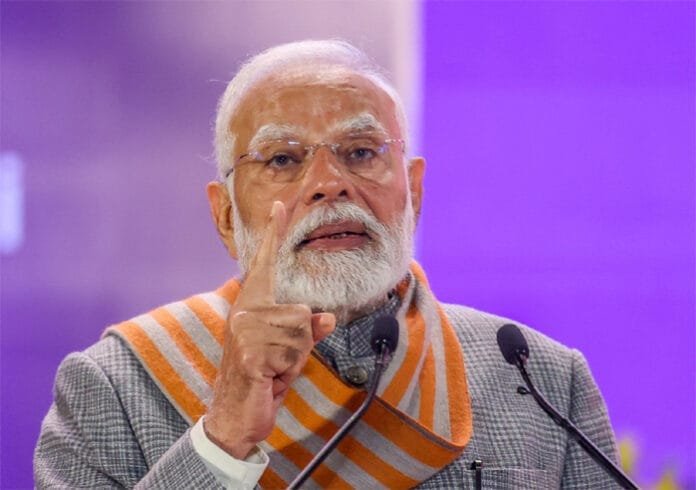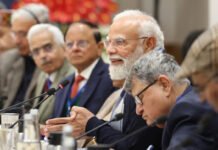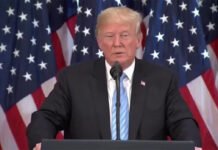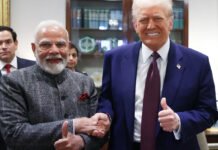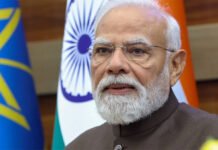The United States’ decision to impose a 50% tariff on Indian exports has sent ripples across global trade corridors. From clothing, gems and jewelry, footwear, sports goods, furniture, to chemicals, several Indian industries are staring at steep export barriers. These tariffs—one of the highest ever imposed by Washington—place India in the same bracket as countries like Brazil and China. The latest move comes after America accused India of continuing oil purchases from Russia, resulting in an additional 25% tariff on top of existing duties.
Yet, despite this blow, India remains poised to withstand the impact. Prime Minister Narendra Modi’s confidence in the resilience of the Indian economy is rooted in structural strengths and ongoing reforms. Below, we examine the six critical fronts from which India can counter this tariff shock and maintain economic momentum.
1. Reliability of the Indian Market
One of the strongest shields against external shocks lies in the trust global investors place in the Indian economy. Over the past decade, India has consistently attracted foreign capital despite global uncertainty. International rating agencies continue to validate this resilience:
Fitch Ratings has stated that the tariff hike’s effect on India’s GDP will remain marginal, as Indian exports to the US comprise only about 2% of the country’s GDP. Importantly, Fitch forecasts a 6.5% GDP growth rate for India in FY 2025-26.
S&P Global recently upgraded India’s credit rating from BBB- to BBB, marking the first upward revision in 18 years. It highlighted India as one of the fastest-growing major economies post-COVID-19.
Such endorsements reinforce India’s position as a reliable investment destination, limiting the potential fallout of US tariffs.
2. Power of the Domestic Market
India’s domestic consumption engine is a powerful buffer against global trade restrictions. A report by the McKinsey Global Institute projects India’s share of world consumption to rise from 9% in 2023 to 16% by 2050, driven by a young, urbanized, and aspirational population.
The scale of India’s domestic demand ensures that industries reliant on export markets can redirect their focus inward. With over 1.4 billion consumers, India holds unmatched capacity to absorb production and sustain demand across sectors, cushioning the blow from external tariff pressures.
3. Strong GST Collections and Fiscal Reforms
India’s Goods and Services Tax (GST) collection figures have emerged as a testament to robust domestic activity:
May 2025: ₹2,01,050 crore collected (16.4% growth from May 2024).
April 2025: A record ₹2.37 lakh crore in GST revenue.
The government’s proactive steps to simplify GST slabs and reduce the tax burden on the middle class are expected to further stimulate consumption. These measures not only strengthen domestic revenue but also offset export losses caused by US tariffs.
The Asian Development Bank’s July 2025 report also projects India’s growth at 6.5%, supported by strong domestic demand, a good monsoon, and lower interest rates.
4. Central Bank’s Success in Controlling Inflation
India’s battle against inflation has yielded encouraging results. Retail inflation in 2025 has dropped to 1.55%, the lowest in eight years, compared to 2.1% in June.
The Reserve Bank of India (RBI) continues to maintain inflation within the government’s target range. ADB forecasts inflation at 3.8% in 2025 and 4% in 2026, both manageable figures.
This control over price stability ensures that Indian households retain purchasing power, while industries face lower input cost pressures. Such monetary stability gives India greater room to absorb tariff-induced challenges without derailing overall growth.
5. Focus on Capital Investment and Infrastructure Growth
India’s strategy to boost capital expenditure is central to long-term resilience. The government is pushing aggressively for infrastructure modernization and domestic manufacturing competitiveness.
Highlights from the February 2025 Union Budget include:
₹1.5 lakh crore in interest-free loans to states for capital investment.
Expanded allocations for infrastructure projects including roads, ports, renewable energy, and industrial clusters.
Such investment enhances India’s manufacturing ecosystem, making it more attractive for foreign investors shifting supply chains away from tariff-hit regions. Strong infrastructure also positions India as a viable alternative to China in global trade networks.
6. India’s Inherent Combativeness and Resilience
India’s economic history is marked by resilience in the face of adversity. The 50% US tariff is undeniably a challenge, but not insurmountable.
From the 1971 Indo-Pak war, to the 1991 balance-of-payments crisis, the 2008 global recession, and the COVID-19 pandemic, India has repeatedly bounced back stronger. The nation’s ability to adapt and innovate in the face of global headwinds fuels the confidence that it can withstand and eventually neutralize America’s tariff pressure.
India’s cultural ethos of “fighting spirit” and its willingness to reform and innovate remain key drivers that ensure its rise even in turbulent global trade environments.
Sectors Most Affected by US Tariffs
The new 50% tariffs primarily target industries where India is a global leader in exports:
Clothing & Textiles – India’s $40 billion apparel export industry will face competitive disadvantages in the US market.
Gems & Jewelry – One of India’s top exports, particularly polished diamonds, will see margin pressures.
Footwear & Leather – Already facing competition from Southeast Asia, additional tariffs could restrict US-bound shipments.
Sports Goods & Toys – A niche yet growing export category now burdened with higher duties.
Furniture & Chemicals – Mid-scale industries will bear the brunt, but domestic consumption could provide a fallback market.
Despite these challenges, India’s diversified export portfolio and growing focus on markets in Europe, Middle East, and ASEAN countries may help offset US losses.
Global Repercussions of America’s Tariff Strategy
The United States risks alienating one of the world’s largest and fastest-growing economies by pursuing such aggressive tariff measures. At a time when Washington is attempting to counterbalance China’s influence, isolating India may have unintended strategic consequences.
India, on the other hand, continues to strengthen trade ties with nations across Asia, Africa, and the Middle East. Efforts to expand BRICS cooperation, enhance India-Gulf trade partnerships, and deepen India-EU economic linkages suggest that New Delhi is well-prepared to pivot beyond the US market.
Conclusion: India’s Path Forward Amid US Tariffs
The 50% US tariff on Indian goods represents a formidable trade challenge. However, India’s robust domestic consumption, resilient fiscal structure, controlled inflation, expanding infrastructure investment, and historical adaptability all stand as pillars of strength.
While exporters in specific sectors will face immediate pressures, India’s long-term growth trajectory remains intact. With global recognition of its economic reliability and the unwavering confidence of Prime Minister Modi’s government, India is prepared not only to endure this tariff attack but to emerge stronger, more diversified, and more self-reliant.
The message is clear: India will not be subdued by protectionist measures. Instead, it will transform challenges into opportunities, strengthening its position as one of the world’s most dynamic economies.

